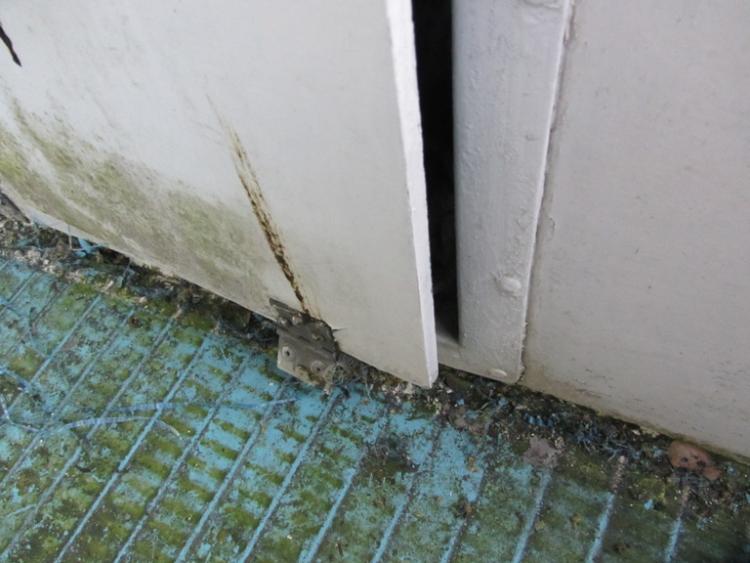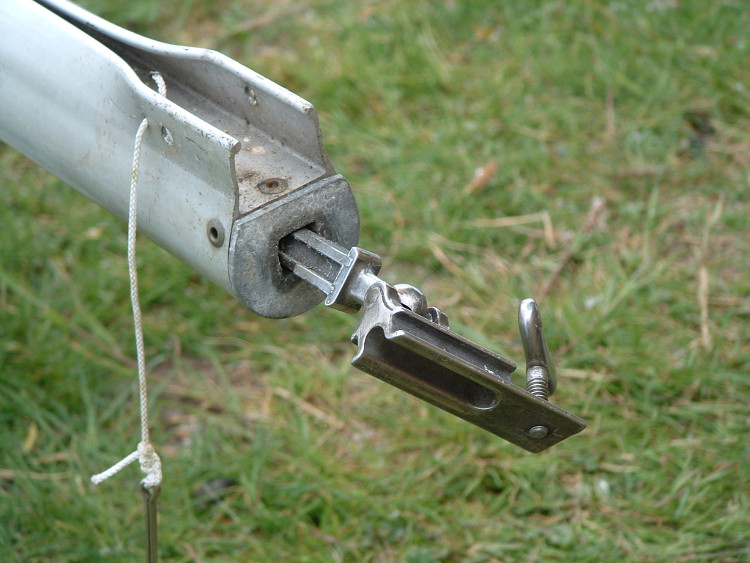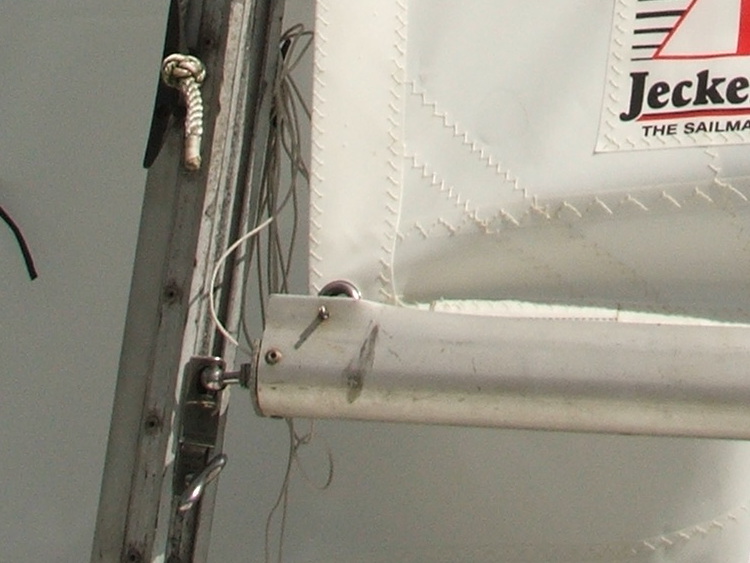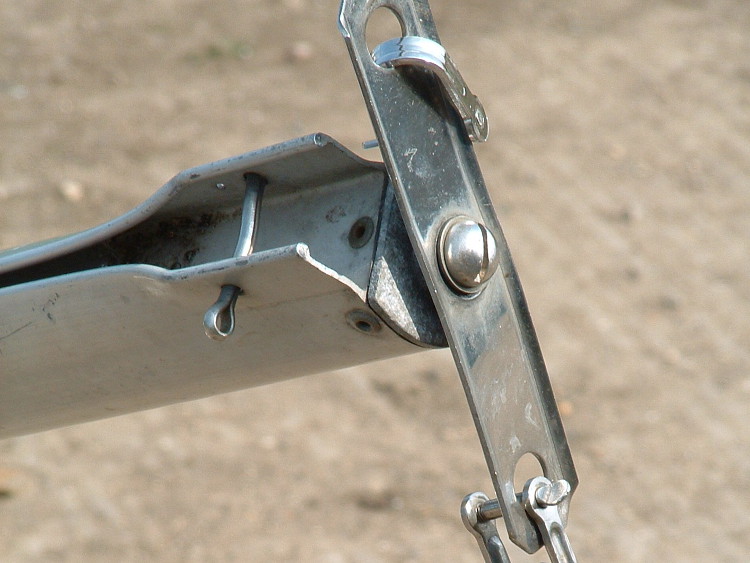#274 Pelican
|
We have owned Pelican since 2010. Problem is, she has been in secure storage most of that time - if anaything, a little too secure..... However, we have now been able to move her somewhere more accessible and with power & water, and access to the sea!
We know virtually nothing of the history of this boat so if anyone can shed any light?? All we know is that she dates from about 1975/76, 4 berth, came with a (no longer functioning) sea toilet, and was originally white with a red hull. Anyway, before she goes back on the water, we have a bit of work to do. This is how she currently looks,   Today's job was to remove the hinges from the lockers and deck lid, as these have been replaced with inferior quality household hinges which, aside from looking awful, had rusted solid. While the locker doors are off, we will give them a rub down and repaint.   Having drilled out the corroded hinge rivets and screws, we turned our attention to the engine mount, which was seized solid. Annoyingly, the pivot bolts sheared off the moment any pressure was applied. Plenty of penetrating fluid applied, we are hoping that a hammer and punch will drift them out, if not we will have a good hour's worth of drilling to do.... The mast had corroded badly at its base; the cast aluminium base was powder and the base of the mast itself was weak. This has been addressed by making up a new base and welding a new section of mast on. Not an easy job....  The corrosion was caused by use of a jubilee clip around the mast to attach the kick strap. I assume the kick should be attached by way of the bolt at the base of the mast - but if anyone has a reference picture I would be most interested to see it. The big jobs that need doing are to lift the boat into the air and refresh the anti fouling and check the operation of the drop keel, and to replace the shredded remains of the jib sail. We also seem to have a surplus of ropes (there are at least two jib halyards, for example); any reference pictures of the mast/sails would be gratefully received...!! Other than that, we have a fair few cosmetic jobs to do, and a decision on whether we repaint or whether to attempt to go back to the gel coat.... Until next time.... |
|
Administrator
|
Hi Kevin and Helen,
Great to hear you are finally getting to work on Pelican. I've just dug up some our previous correspondence from around the time you bought Pelican and realise that it was both of you (and your brother?) that I met when visiting my sister back in September 2010. I also looked at the photographs you sent to me around that time. I see that that jubilee clip was nice and shiny then. Such a shame you didn't realise (nor would I have done!) how necessary it was to get rid of it immediately. Looking at the correspondence I see you'll already know about as much as I do about Pelican and, from the photographs at: http://groups.yahoo.com/group/seahawk17/photos/album/1462012042/pic/list will be aware that she was sold via eBay in 2007. Good luck with the continuing restoration.
Greg Chapman
GregAfloat - My Boating Biography |
|
Administrator
|
In reply to this post by Pelican
Hi Kevin,
I see I missed a response to this bit... Unfortunately, I had a tabernacle fitted soon after buying my boat and it seems I have no pictures of the kicking strap from that time. (I recall thinking that I was happy to see the boom lift in a gust and was happy to let wind spill that way.) However, I believe you are right and had I got round to using a kicking strap I would have fitted a shackle to the mast "hinge bolt" to secure the strap. The best pictures I have are in my report of a cruise up Waxham Cut in 2006. You clear blue water sailors may think we ditch crawlers are sissies when it comes to waves and other maritime dangers, but we inland sailors have other navigational hazards to encounter! You won't be able to make it out, in the second to last image, but the lower block on my strap incorporates a V to wedge the line in after hauling it tight. Let me know if the images in the Waxham Cut cruise report don't give you enough clues about halyards and I'll see if I can dig out some more helpful pictures.
Greg Chapman
GregAfloat - My Boating Biography |
|
In reply to this post by Pelican
I remember now, that all seems so long ago now! Thanks for the link - that is really helpful and it does give us some idea of how things work. Watch this space!! |
|
In reply to this post by Pelican
Today's job was to try and free off the outboard motor mounting. The mounting was completely immovable so that the outboard could not be raised or lowered. The reason became apparent when the pivot bolts sheared as soon as any pressure was applied. Yep - another bodge... mild steel bolts had rusted solid in the aluminium mounting. The only solution is going to be drilling the old bolts out. Following that we had a look at how the main sail was attached to the boom - via a bolt through the rear of the boom where presumably an outhaul would have been mounted. Such an arrangement must have left a large gap between sail and mast... However it did get us thinking about how the outhaul should be attached. Clearly there is no internal pulley system in the boom, and there are no cleats on the boom as I have used on other boats. Would be interested to hear how other owners arrange outhauls? Until next time.. |
|
Administrator
|
Hi Kevin,
I am not sure from your description whether you have a standard SSS boom. I'll add something along the lines of the following to the main part of the site in the near future as I realise that it is an obvious question that should be covered there. Below are images of my SSS mast and boom, which should be the same as yours, as they are very similar aged boats. The top of the boom should have a channel in it into which you thread the rope sown to the foot of the sail. At the forward end a split pin is passed through a eye in the corner of the sail :   Note that there is no need to separate the ends of the pin, which you need to be able to remove when you pack the sails away. The tension in the sail's foot when you secure the other end may well be enough to begin to bend the pin in its centre and that seems to hold it in place. (On the main site I'll clean up the image to remove all that confusing burgee halyard!) Now the end you're interested in. This has a similar split pin to the front. Ideally, this image would show the other side with the two parts of the pin bent apart so it can't fall out.  I wish I had a better close-up of the sail fitted... (If anyone can supply a better one do post it!)  The mainsail should have about three feet of lanyard attached to the aft end of the foot. With the front end of the sail secured as shown in the first images above, the lanyard is pulled taught. That should leave the aft end of the sail around 6" short of the split pin at the aft end of the boom. The lanyard is then passed round the split pin and back to the eye in the corner of the sail. With a couple of loops between sail and pin you get a surprising amount of leverage to stretch the foot of the sail tight. Tie it off with with a two or three half hitches, so that there is only a few inches left and push any spare into the boom channel so it doesn't flay about and risk taking your eye out should it get loose! And that's it. No pulleys! No cleats! Just a couple of split pins and a few loops of cord are all there is to it.
Greg Chapman
GregAfloat - My Boating Biography |
|
In reply to this post by Pelican
That's really helpful, once again Greg, many thanks for your help - we owe you a pint I think! We have the SSS spars exactly as pictured, and its good to know we are not missing anything here, other than the lanyard on the sail which is very easily sorted - makes a pleasant change!!! |
|
Progress is being made....
the old antifouling has been cleared off and renewed. The old paintwork really has to go.... the surface of the 'slats' resembled the surface of the moon, there are numerous chips and scratches, and it is peeling off all over the place. A few afternoons have seen the bottom half of the boat sanded down... dusty and tedious work but the end result will be well worth the effort. The red patches are where the paint had flaked off, and is the original GRP colour.   |
«
Return to Pelican
|
1 view|%1 views
| Free forum by Nabble | Edit this page |

